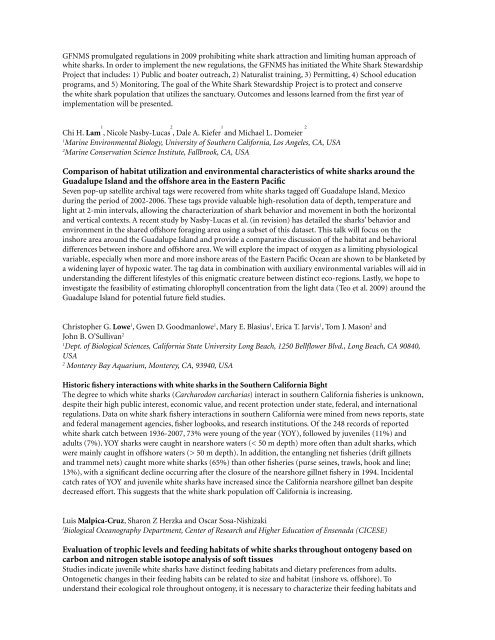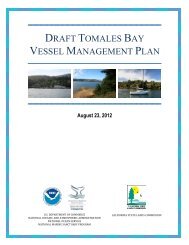Symposium program - Gulf of the Farallones National Marine ...
Symposium program - Gulf of the Farallones National Marine ...
Symposium program - Gulf of the Farallones National Marine ...
Create successful ePaper yourself
Turn your PDF publications into a flip-book with our unique Google optimized e-Paper software.
GFNMS promulgated regulations in 2009 prohibiting white shark attraction and limiting human approach <strong>of</strong><br />
white sharks. In order to implement <strong>the</strong> new regulations, <strong>the</strong> GFNMS has initiated <strong>the</strong> White Shark Stewardship<br />
Project that includes: 1) Public and boater outreach, 2) Naturalist training, 3) Permitting, 4) School education<br />
<strong>program</strong>s, and 5) Monitoring. The goal <strong>of</strong> <strong>the</strong> White Shark Stewardship Project is to protect and conserve<br />
<strong>the</strong> white shark population that utilizes <strong>the</strong> sanctuary. Outcomes and lessons learned from <strong>the</strong> first year <strong>of</strong><br />
implementation will be presented.<br />
Chi H. Lam 1 , Nicole Nasby-Lucas 2 , Dale A. Kiefer 1 and Michael L. Domeier 2<br />
1<br />
<strong>Marine</strong> Environmental Biology, University <strong>of</strong> Sou<strong>the</strong>rn California, Los Angeles, CA, USA<br />
2<br />
<strong>Marine</strong> Conservation Science Institute, Fallbrook, CA, USA<br />
Comparison <strong>of</strong> habitat utilization and environmental characteristics <strong>of</strong> white sharks around <strong>the</strong><br />
Guadalupe Island and <strong>the</strong> <strong>of</strong>fshore area in <strong>the</strong> Eastern Pacific<br />
Seven pop-up satellite archival tags were recovered from white sharks tagged <strong>of</strong>f Guadalupe Island, Mexico<br />
during <strong>the</strong> period <strong>of</strong> 2002-2006. These tags provide valuable high-resolution data <strong>of</strong> depth, temperature and<br />
light at 2-min intervals, allowing <strong>the</strong> characterization <strong>of</strong> shark behavior and movement in both <strong>the</strong> horizontal<br />
and vertical contexts. A recent study by Nasby-Lucas et al. (in revision) has detailed <strong>the</strong> sharks’ behavior and<br />
environment in <strong>the</strong> shared <strong>of</strong>fshore foraging area using a subset <strong>of</strong> this dataset. This talk will focus on <strong>the</strong><br />
inshore area around <strong>the</strong> Guadalupe Island and provide a comparative discussion <strong>of</strong> <strong>the</strong> habitat and behavioral<br />
differences between inshore and <strong>of</strong>fshore area. We will explore <strong>the</strong> impact <strong>of</strong> oxygen as a limiting physiological<br />
variable, especially when more and more inshore areas <strong>of</strong> <strong>the</strong> Eastern Pacific Ocean are shown to be blanketed by<br />
a widening layer <strong>of</strong> hypoxic water. The tag data in combination with auxiliary environmental variables will aid in<br />
understanding <strong>the</strong> different lifestyles <strong>of</strong> this enigmatic creature between distinct eco-regions. Lastly, we hope to<br />
investigate <strong>the</strong> feasibility <strong>of</strong> estimating chlorophyll concentration from <strong>the</strong> light data (Teo et al. 2009) around <strong>the</strong><br />
Guadalupe Island for potential future field studies.<br />
Christopher G. Lowe 1 , Gwen D. Goodmanlowe 1 , Mary E. Blasius 1 , Erica T. Jarvis 1 , Tom J. Mason 2 and<br />
John B. O’Sullivan 2<br />
1<br />
Dept. <strong>of</strong> Biological Sciences, California State University Long Beach, 1250 Bellflower Blvd., Long Beach, CA 90840,<br />
USA<br />
2<br />
Monterey Bay Aquarium, Monterey, CA, 93940, USA<br />
Historic fishery interactions with white sharks in <strong>the</strong> Sou<strong>the</strong>rn California Bight<br />
The degree to which white sharks (Carcharodon carcharias) interact in sou<strong>the</strong>rn California fisheries is unknown,<br />
despite <strong>the</strong>ir high public interest, economic value, and recent protection under state, federal, and international<br />
regulations. Data on white shark fishery interactions in sou<strong>the</strong>rn California were mined from news reports, state<br />
and federal management agencies, fisher logbooks, and research institutions. Of <strong>the</strong> 248 records <strong>of</strong> reported<br />
white shark catch between 1936-2007, 73% were young <strong>of</strong> <strong>the</strong> year (YOY), followed by juveniles (11%) and<br />
adults (7%). YOY sharks were caught in nearshore waters (< 50 m depth) more <strong>of</strong>ten than adult sharks, which<br />
were mainly caught in <strong>of</strong>fshore waters (> 50 m depth). In addition, <strong>the</strong> entangling net fisheries (drift gillnets<br />
and trammel nets) caught more white sharks (65%) than o<strong>the</strong>r fisheries (purse seines, trawls, hook and line;<br />
13%), with a significant decline occurring after <strong>the</strong> closure <strong>of</strong> <strong>the</strong> nearshore gillnet fishery in 1994. Incidental<br />
catch rates <strong>of</strong> YOY and juvenile white sharks have increased since <strong>the</strong> California nearshore gillnet ban despite<br />
decreased effort. This suggests that <strong>the</strong> white shark population <strong>of</strong>f California is increasing.<br />
Luis Malpica-Cruz, Sharon Z Herzka and Oscar Sosa-Nishizaki<br />
l<br />
Biological Oceanography Department, Center <strong>of</strong> Research and Higher Education <strong>of</strong> Ensenada (CICESE)<br />
Evaluation <strong>of</strong> trophic levels and feeding habitats <strong>of</strong> white sharks throughout ontogeny based on<br />
carbon and nitrogen stable isotope analysis <strong>of</strong> s<strong>of</strong>t tissues<br />
Studies indicate juvenile white sharks have distinct feeding habitats and dietary preferences from adults.<br />
Ontogenetic changes in <strong>the</strong>ir feeding habits can be related to size and habitat (inshore vs. <strong>of</strong>fshore). To<br />
understand <strong>the</strong>ir ecological role throughout ontogeny, it is necessary to characterize <strong>the</strong>ir feeding habitats and







